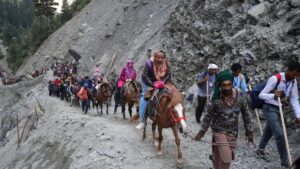Table of Contents
Appointment of Election Commissioners
Context: The committee headed by the PM conducted a meeting for the appointment of a new Election Commissioner.
How are the CEC and ECs currently Appointed?
- Article 324 provides the structure of the Election Commission of India (ECI), comprising the Chief Election Commissioner (CEC) and two additional Election Commissioners (ECs).
- The President is responsible for appointing the CEC and ECs, subject to the provisions of any legislation enacted by Parliament (provided in Constitution).
- Appointment Process: The Chief Election Commissioner (CEC) and Election Commissioners (ECs) will be appointed by the President upon the recommendation of a Selection Committee.
- Under the New : Chief Election Commissioner and Other Election Commissioners (Appointment, Conditions of Service and Term of Office) Act, 2023.
Selection Committee: The Selection Committee will consist of:
- Prime Minister
- Union Cabinet Minister
- Leader of Opposition/leader of the largest opposition party in Lok Sabha
- Search Committee: A Search Committee headed by the Cabinet Secretary will propose a panel of names to the Selection Committee.
- Eligibility: To be eligible for the posts, candidates must have held (or currently hold) a post equivalent to the Secretary to the central government.
We’re now on WhatsApp. Click to Join
| PYQ |
Q. Consider the following statements :
Which of the statements given above is/are correct? (a) 1 and 2 only (b) 2 only (c) 2 and 3 only (d) 3 only Answer: Option (d) |
Understanding the delimitation exercise
Context: India’s next delimitation of constituencies, originally planned for 2021 Census, is delayed due to pandemic and government reasons. It will now be based on the first Census after 2026.
| Fact
● 42nd CAA, 1976: Initially froze seat allocation until 2000. ● 84th CAA, 2001: It froze constituency boundaries until the first census after 2026, or at least until after 2031. |
What is Delimitation?
- Delimitation means the process of fixing the number of seats and boundaries of territorial constituencies in each State for the Lok Sabha and Legislative assemblies.
- Performed by: Delimitation Commission that is set up under an Act of Parliament.
- Such an exercise was carried out after the 1951, 1961 and 1971 Census.
- Constitutional Provision:
- Article 82: After every Census, the Parliament enacts a Delimitation Act, and the central government sets up a Delimitation Commission. This is to ensure that the electoral divisions are redrawn based on the latest data.
- Article 170: States that adjustments and divisions into territorial constituencies are to be made in such a way that the ratio between the population and the number of seats allotted to each constituency is the same throughout the state.
What are the Issues?
- Population Growth Disparity: Since 1971, population growth in India has been uneven, with states like Uttar Pradesh, Bihar, Madhya Pradesh, and Rajasthan experiencing greater increases compared to states like Kerala, Tamil Nadu, Karnataka, and Andhra Pradesh.
- Delimitation Options: Discussions in the public domain focus on two options post-2026:
- Maintaining the current 543 Lok Sabha seats with redistribution among states, or
- Increasing the seats to 848, with proportional increases across states.
- Southern States Disadvantage: Both proposed delimitation scenarios could disadvantage southern states, smaller northern states like Punjab, Himachal Pradesh, and Uttarakhand, and northeastern states compared to larger northern states.
- Federal Principle Concerns: The potential redistribution of seats may conflict with federal principles, potentially leading to feelings of disenfranchisement among states that may lose representation.
- Contradiction of Past Policies: The changes may contradict the initial philosophy of freezing Lok Sabha seats based on the 1971 Census, penalising states that have effectively controlled their population growth.
International Practices for Constituency Delimitation
|
Other Information |
United States
European Union
|
Suggestive Measures
- Balancing Democracy and Federalism: Harmonise democratic and federal principles by giving them equal weight in the delimitation exercise.
- Upholding Federal Principles: Keep the Lok Sabha seat cap to respect the federal structure while addressing representational needs through state assemblies.
- Empower Local Governments: Strengthen democracy by significantly enhancing the powers and financial resources of panchayats and municipalities.
- Local Level Democratic Engagement: Focus on enabling local bodies to effectively serve and interact with citizens on a daily basis.
Ethanol Blending
Context: Emphasising India’s progress in the biofuel sector, PM Modi highlighted a significant rise in ethanol blending from 1.5% in 2014 to 12% in 2023 leading to a reduction in carbon emissions by about 42 million metric tons.
Ethanol Blending
- Ethanol blending refers to the process of mixing ethanol with gasoline to create a fuel blend.
- Ethanol is combined with gasoline in varying proportions.
- The most common blends include E10 (10% ethanol and 90% gasoline), E15 (15% ethanol and 85% gasoline), and E85 (85% ethanol and 15% gasoline) for vehicles designed to run on higher ethanol concentrations.
| What Is Ethanol? |
|
Advantages of Ethanol Blending
- Reduced reliance on fossil fuels: Biofuels decrease dependence on limited and polluting fossil fuels, lowering greenhouse gas emissions and mitigating climate change.
- For example: Grain-based ethanol cuts greenhouse gas emissions significantly by 44 to 52% compared to gasoline, according to the US Department of Energy’s Argonne National Laboratory.
- Renewable energy source: Biofuels are grown from renewable crops, ensuring long-term energy availability unlike finite fossil fuels.
- Support for agriculture: Biofuel crops create a new market for farmers, boosting rural economies and providing additional income.
- Technological advancement: Research in biofuel technologies drives innovation in the renewable energy sector, leading to further advancements.
Hot Money
Context: India will monitor flows of foreign funds after its inclusion into JPMorgan’s emerging market debt index and take steps to avoid ‘hot money’.
What is Hot Money?
- Hot money is capital that investors regularly move between economies and financial markets to profit from highest short-term interest rates
- Short-term investments: Moves quickly between markets seeking high short-term returns.
- Profit-driven: Aims to lock in highest available interest rates.
- Volatility risk: Can cause sudden capital outflows, destabilising currency and bond markets.
- Example: Foreign Portfolio Investment (FPI) often viewed as “hot money” due to its sensitivity to economic fluctuations.
- Attraction strategy: Banks use short-term certificates of deposit (CDs) with high interest rates to attract “hot money”.
- Dynamic movements: Investors readily switch to better offers, withdrawing funds whenever rates drop or better options appear elsewhere.
Atmospheric River
Context: Southern California is inundated by massive rainfall which was caused by atmospheric river.
What Is An Atmospheric River?
- An atmospheric river is a long, narrow region in the atmosphere that transports significant amounts of water vapour.
- According to the U.S. Department of Energy, these are like rivers in the sky and can carry moisture from the tropics near the equator toward the poles.
- On average, the Earth has about five atmospheric river events at any time, each capable of carrying an amount of water vapour equivalent to the liquid water flow of the Amazon River.
- When they make landfall, atmospheric rivers release this moisture, often resulting in heavy snow and rain.
Atmospheric River Benefits
- Bringing Much-Needed Rainfall: In areas like Southern California, which may face drought conditions, atmospheric rivers can bring significant rainfall to replenish water resources and reservoirs.
- Supporting Aquatic Life: The rainfall can help fill rivers and streams, supporting aquatic life that may have suffered during dry periods, such as the Chinook salmon in Northern California.
Risks Associated
- Flooding and Landslides: The heavy rainfall can lead to flooding and landslides, particularly in regions where the soil cannot absorb the water quickly enough.
- Disruption to Wildlife: While the moisture can foster wildlife growth, sudden and intense rainfall can alter habitats and become turbulent for aquatic life when the weather turns dry again.
- Damage to Infrastructure: The severe weather conditions associated with atmospheric rivers can lead to property damage and can strain infrastructure not designed to handle such large amounts of water.


 Operation Shiva 2025: Indian Army’s Ma...
Operation Shiva 2025: Indian Army’s Ma...
 World Youth Skills Day 2025, Theme, Hist...
World Youth Skills Day 2025, Theme, Hist...
 President Murmu Nominates Four Members t...
President Murmu Nominates Four Members t...





















